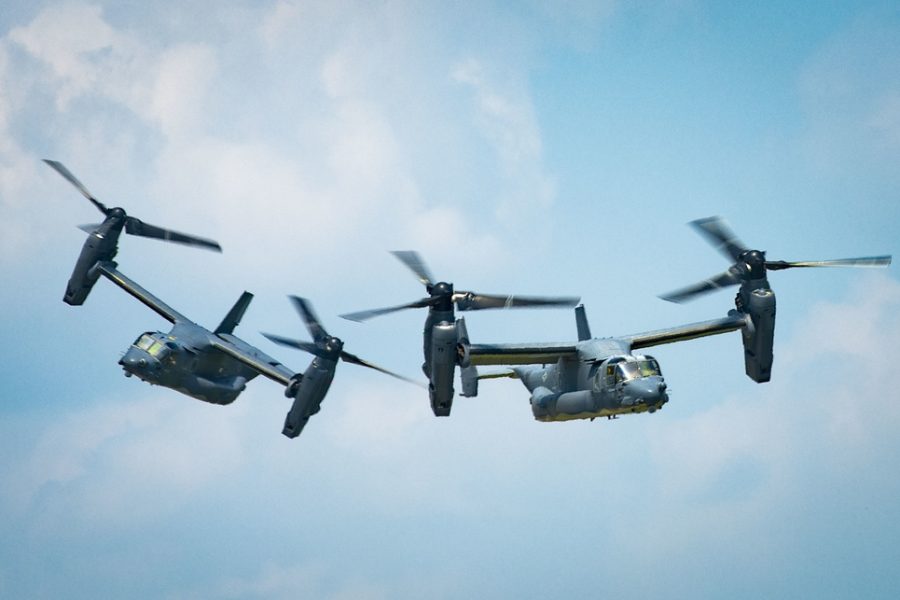Air Force Special Operations Command has been rotating its CV-22 aircraft into “flyable storage” status at Cannon Air Force Base, N.M., as it works to upgrade components in the movable nacelles, the engine housings and transmission lines that give the aircraft its unique tiltrotor capabilities.
The work began in 2022 and will continue into 2026.
The previously unreported program is part of a larger effort to improve mission availability for the Osprey, but it won’t be clear until late 2025 if the changes are making enough of a difference to restore the full fleet to operational squadrons.
Rep. Ronny Jackson (R-Texas) raised the topic of CV-22 readiness during the House Armed Services Committee’s markup of the 2025 National Defense Authorization bill.
“The committee is aware of the force structure proposals for the fleet of CV-22 Osprey aircraft that are being considered by the Department of the Air Force and U.S. Special Operations Command,” Jackson wrote in language adopted by the committee. Today, he said, 15 of the 51 CV-22 Osprey aircraft in the Air Force inventory “are in flyable storage with the intent of returning to an operational squadron no earlier than fiscal year 2026.”
An AFSOC spokeswoman confirmed that the aircraft were in storage in response to a query from Air & Space Forces Magazine.
Flyable storage means the aircraft can be put back in the inventory if needed, but spreads the available operations and maintenance funds across fewer aircraft, enabling higher availability rates. The Air Force applied a similar strategy in recent years to the B-1B bomber fleet, retiring some of the bombers so it could focus sustainment funding on fewer aircraft.
“Air Force Special Operations Command placed 15 CV-22s in Flyable Storage at Cannon Air Force Base, N.M., in FY22 to better support modification lines for a number of aircraft improvements, most notably the Nacelle Improvement program designed to simplify maintenance actions and raise the fleet’s aircraft availability rate,” the spokeswoman said.
AFSOC’S Nacelle Improvement Program began in September 2021, with the Air Force contracting Osprey maker Bell Textron to do the work. In 2022, then-Lt. Col. Jonathan Ball said in a video that “60 percent of the maintenance occurs in the nacelles. So what this allows us to do is really address and improve on those reliability and sustainment issues that we’ve seen and learned from over the last decade, but still have the same amazing capability moving forward.”
About half the CV-22 fleet has received the upgrade so far.
Safety issues have haunted the Osprey since early in its development. But advocates say the data does not support its reputation for safety incidents. The program has come under increasing scrutiny in recent years after a series of fatal crashes and two periods when AFSOC paused flight operations while investigating concerns related to the aircraft’s clutch system, in particular.
In November, a CV-22 crashed off the coast of Japan, killing all eight Airmen on board. Investigators blamed the crash on an unspecified material failure. A military-wide V-22 grounding that was lifted in March, but the aircraft’s operations are still limited.
“We are gaining better fidelity on the effectiveness of the nacelle improvements on fleet readiness,” the AFSOC spokeswoman said. “We believe we will have sufficient data by late 2025 to inform a decision whether to return the flyable storage aircraft to operational squadrons.”
Jackson’s amendment to the House version of the Authorization bill says Congress is “aware of and very concerned by recent proposals to move multiple CV-22 Osprey aircraft to a long-term preservation site.”
Asked if the Air Force has pending proposals or plans to change the Osprey’s force structure, the AFSOC spokeswoman responded: “There have been no further decisions on the CV-22 fleet status since those program changes in FY22.”
However, an April force structure report issued by the Pentagon indicates the Air Force is seeking to retire two CV-22s in 2025. However, the report notes that “two CV-22s will be delivered immediately prior to two divesting.” The report shows no other planned CV-22 retirements through 2029.
As part of the reporting language Jackson introduced into the NDAA, the Secretary of the Air Force and U.S. Special Operations Command commander would have to provide a briefing to lawmakers by December 2024 including:
- A detailed force structure and preservation plan for the CV-22
- A review of any manpower shortfalls over the last three years
- The impact of the Nacelle Improvement program
- Investments needed for “safety, reliability, survivability, and capability”
- Analysis of “any recent changes to the maintenance protocols over the last three years” for the CV-22
- Any funding that has been diverted away from the CV-22
Elsewhere in the House Armed Services Committee version of the NDAA, lawmakers authorized an extra $125 million for procuring V-22 safety enhancements. The additional funds still must be approved by the Senate and by appropriators in both chambers.

